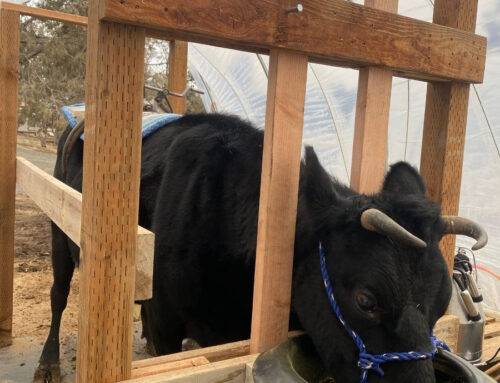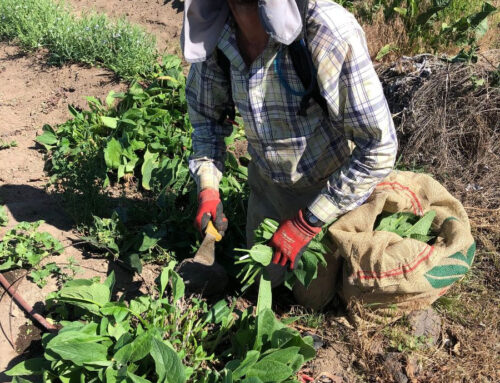
News from the Farm
This past week we stepped back and looked around and realized it was finally summer. The temps increased, those afternoon breezes started kicking up, and holy moly, the flowers began to bloom everywhere. While the temperatures weren’t crazy hot last week (does anyone remember last year at this time: fires everywhere, triple digits!!), it was a great reminder for us of what was coming, how to adapt our bodies to working outside in the heat, and what happens to all the plants and animals under our care as the summer well and truly becomes summer.
We took the walls down on the deck so we all have a comfortable place to sit in the shade and meet, rest, or eat. This is also nice for our brunch guests!
We made sure the irrigation timers were working and set correctly in the hoops, tomato houses, 2-acre, and the landscaping around the Farm Store.
We opened the walls up on all the hoops to maximize air flow.
We started getting back into the habit of spraying down the pigs in the middle of the day so they could enjoy the mud and cool down.
We found our long sleeve shirts and wide brimmed hats, salt pills, and camelbacks.
We reacquainted ourselves with the pond for soaks mid day and after work.
Generally, we remembered and rebuilt the habits that will sustain us through the long hot days ahead! Sunday and Monday will be a test of these habits and we are already looking forward to the coolness of Tuesday and Wednesday. (Although when you are weeding in the hoop houses, 80 degrees still feels way too hot!)



photo by: Melissa Harmon (dog), Zoë Griffith (cucumber); Natalie Leder (flowers)
Olive, Nat’s dog, shows us how to cool down as the temperatures rise. Zoë cuts into the first cucumber to check out its fractaled beauty. The cucumbers are starting to come on strong! Apprentice Camila shows off the beauty of bolted Asian Greens. After we clear a bed of Asian Greens, we take the flowers, stems, roots, and everything to the pigs for a delicious, healthy snack!
Veggie ID: Oregano

Basic Info: Oregano has one of the stronger flavors in the herb department. You might want to use them sparingly when you are looking for an herb flavor that isn’t as bright as basil or deep as sage. If your bunch comes with flowers, you can use these in salads or as a garnish.
To store: Keep the leaves dried, but consider putting the whole bunch in a glass of water in your fridge. If you don’t think you will be using the whole bunch in a week, start drying your bunch now so you can have freshly dried oregano to use later! (I promise, freshly dried herbs knock the herb flavor out of the park!)
To dry/preserve fresh herbs: you can dry herbs a few different ways: hang-drying, oven-drying, or using a home dehydrator.
- hang-drying: Tie sprigs or branches into small bunches (way better then larger ones, this allows the air to circulate more freely). Hang the bunches leaves pointing downward and wrap the herbs loosely in muslin or a thin paper bag with small holes poked in it to collect falling leaves or seeds. Don’t use plastic bags because the herb will mold. Dry for 7 to 10 days. The herbs are ready when they’re flaky and easy to crush. Store them in small airtight containers after you have crumbled them.
- oven-drying: space out the leaves or branches on a baking sheet and place in an oven at the lowest setting. Leave to door ajar so moisture will escape. Turn the leaves over at 15 minutes so the herbs will dry evenly. Turn the oven off after an hour and leave the herbs in there until the whole thing cools completely. Store them in small airtight containers after you have crumbled them.
To use: Oregano pairs well with lemon in marinades, salad dressings, or in a mixed green salad or grain based salad.
Vegetable CSA Harvest List
We think our foundation vegetables this week will be: salad turnips, green onions, oregano, and lettuce. We will let you know on Wednesday how many other items you will get to select.
We have been keeping an eye on the hoops and 2-acre garden and have a pretty good idea of what is out there and ready to be harvested, but this is a Sunday estimation of what we will be harvesting on Tuesday. Also, because we have a market style CSA, this isn’t a guarantee of 1 of all these things for everyone. Instead, this will be the variety of what will hopefully (fingers crossed) have for you to choose from this week.)
Other Vegetable Options will probably include:
Arugula
Asian Greens
Basil
Beets
Broccoli
Carrots
Chard
Cucumbers
Dill
Peas
Spinach
Fennel
Kale
Napa Cabbage
Parsley
Radish
thyme
Yod Fah
zucchini
chamamile
garlic scapes
Meat CSA
This week our Meat CSA features beef and a ham steak!
Large CSA (10lbs)
1 quart lard
2 packages steaks (could be t-bone, rib steak, top sirloin, or another cut)
1 bottom round roast
1-3 ground beef (depending on total weight of above items)
Small CSA
1 quart lard
1 steak (could be t-bone, rib steak, top sirloin, or another cut)
1-2 lbs ground beef (depending on total weight of above items)
|
|
Lard

Lard is rendered pork fat that we cook down from the fat we get back from the butcher. The strained product is an incredible cooking fat. You can use it as you would any other cooking fat – butter, olive oil, coconut oil, etc. Our favorite things to do with lard include:
- sautéing veggies
- cooking meat
- seasoning with herbs and stuffing it between the skin and the meat on a Rainshadow Chicken
- Frying eggs
- baking for pie crusts, biscuits, and even granola.
The lard you received with your meat share is frozen. You can pop it back in the freezer and save it for pie season, (Wait, isn’t pie season year round!) or, what I recommend and always do, it so put the quart in your fridge. Now, don’t stick it in the back and forget about it, instead keep it in the front and each time you go to reach for butter to sauté something in, try the lard instead. Maybe put a post it note on your oil of choice (olive oil, coconut, sunflower, whatever) that says LARD!!! so you will reach for the oil and be reminded of this real, honest food option to use instead. Our lard is NOT hydrogenated which means that it isn’t shelf stable and this time of year should definitely be stored in your fridge.
Why lard? Because you know exactly where it comes from: Rainshadow Hogs, Rainshadow’s kitchen. This is a Central Oregon born and raised and rendered cooking ingredient.
Recipe Corner
Every week I try to send along a few recipes that utilize the meats and vegetables in your CSA share. This week, is smattering of stuff showcasing the variety of what we have for you to choose from this week!

photo credit: Camila Becerra Riroroco
|
|
Adapted from Deborah Madison’s Vegetarian Cooking for Everyone
INGREDIENTS
1 bunch greens, stems removed and leaves blanched
1 tablespoons olive oil (go ahead, try the lard here!)
1 bunch green onions, including 2 inches of the green, sliced
3 tablespoons chopped mixed herbs (basil, parsley, oregano, anything will work great here!)
salt and pepper to taste
INSTRUCTIONS
- Coarsely chop the blanched greens. Warm the oil in a wide skillet over medium heat, then add the green onions and herbs. Cook gently until wilted and fragrant. Add the greens to the onion/herb mix and cook until heated through. Season with salt and pepper.
|
|
|

Can’t wait to see you on Wednesday! Don’t forget it is a meat week!
The Farm Crew






